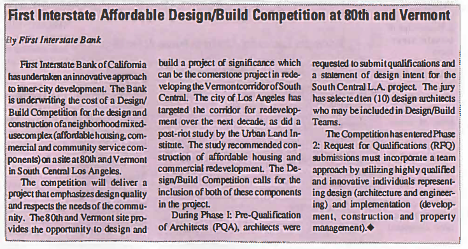First Interstate Bank owns a major parcel of land at 80th and Vermont in South Central Los Angeles: the bank wants to build a housing development, while some neighbors want a commercial development. Peter Dreier, E.P. Clapp Distinguished Professor at Occidental College and Former Director of Housing for the City of Boston (1984-92). Mr. Dreier unroots the larger issues in this dilemma: 1) the history of banks' redlining in South Central; 2) City Hall inaction; and 3) community groups and elected officials conflict.
Below, TPR also presents First Interstate Bank's affordable design plan description.

"... banks (including First Interstate) have a long history of redlining South Central and other neighborhoods of color."
The controversy over the Vermont and 80th Street site is a brushfire battle in a longer war about the future of Los Angeles' neighborhoods.
First Interstate Bank owns the option on a major parcel of land at 80th and Vermont in South Central Los Angeles. The bank wants to build a housing development there. Some neighbors like the idea, recognizing the shortage of decent affordable housing in the neighborhood. Other neighbors oppose the project. They think the site is better-suited for a commercial project with stores that can provide retail services that the community currently lacks. The debate over this site has pitted neighbor against neighbor, and elected officials against elected officials.
Pitting housing against commercial development is an exercise in futility. Healthy neighborhoods require both. But this controversy is rooted in several larger issues about how to go about community and economic development in poor and working class neighborhoods.
First, banks (including First Interstate) have a long history of redlining South Central and other neighborhoods of color. The federal Community Reinvestment Act (CRA) was passed in 1977, and strengthened (with Congresswoman Maxine Water's help) in 1990, to encourage banks to invest in low-income and minority areas. The federal government's carrot-and-stick approach has worked. Goaded by grassroots community pressure on banks and federal bank regulators, the CRA has been a useful tool in promoting bank-community partnerships to expand housing loans in poor neighborhoods. Experience demonstrates that these loans were good business decisions, not charity. By creating housing on the Vermont & 80th site, First Interstate will both make money and improve its CRA rating. What's needed is an amendment to the CRA to require banks to make commercial loans, and open branches, in these underserved neighborhoods. Then, First Interstate and other banks would have a greater incentive to open branches and invest in small business and retail stores, all of which would provide much-needed jobs as well as help improve the community. Also, California should have its own Community Reinvestment Act, as several other states already do, to promote bank lending throughout the state.
Second, City Hall could help by putting its money where its mouth is. Several years ago, Councilman Mark Ridley-Thomas sponsored a farsighted linked-deposit plan to put the city government's own deposits only in banks with track records of meeting community needs. Unfortunately, the City Hall bureaucracy has not adequately implemented the plan. To make it work, the Riordan Administration should research and publish an annual banking "report card." It should go beyond the 1991 city-sponsored redlining report, "Taking It To The Bank," by not only looking at which neighborhoods are being redlined, but also by specifically evaluating each bank's track record. It should look at mortgage lending, branch sites, small business loans, and employment. The city should visibly reward those banks with good grades by shifting its deposits into them and visibly sanction banks with poor grades by pulling out its deposits. Moreover, the Riordan Administration could encourage private organizations, churches and synagogues, unions, and other institutions to do likewise. Basically, the city and other institutions should not put their deposits in banks that don't invest in the city's low-income and working class neighborhoods. Likewise, the state could adopt its own "linked deposit" policy, which, given the size of the state's deposits, would have an enormous impact on bank behavior.
Finally, community groups and elected officials have to find ways to work together, even when they differ on short-term projects. Reasonable people will have differences of opinion about what should be done on a specific site, but these differences are exacerbated because the community residents have little input in shaping their neighborhoods' future. If community groups are always on the receiving end of a series of development projects proposed by city officials and developers, they will naturally resent the process. They need to be part of an overall planning process from the beginning, so that each proposed project is part of a larger scheme that the community feels is theirs.
To realize this goal, City Hall needs a long-term plan for the overall improvement of South Central and other neighborhoods and must give community residents a strong voice in shaping that plan. They should not have to react to each proposed project on a case-by-case basis. In Boston, under Mayor Ray Flynn, we revised the city's out-of-date zoning and development plan on a neighborhoodby-neighborhood basis, working closely with community organizations. We looked at all aspects of neighborhood revitalization: economic development, housing, zoning, open space, and infrastructure and capital projects (i.e. street improvements, lighting). City agencies that rarely worked together were forced by this process to coordinate their efforts. It took both leadership at the top (the mayor) and leadership at the grassroots community level to accomplish this difficult but necessary task.
- Log in to post comments




